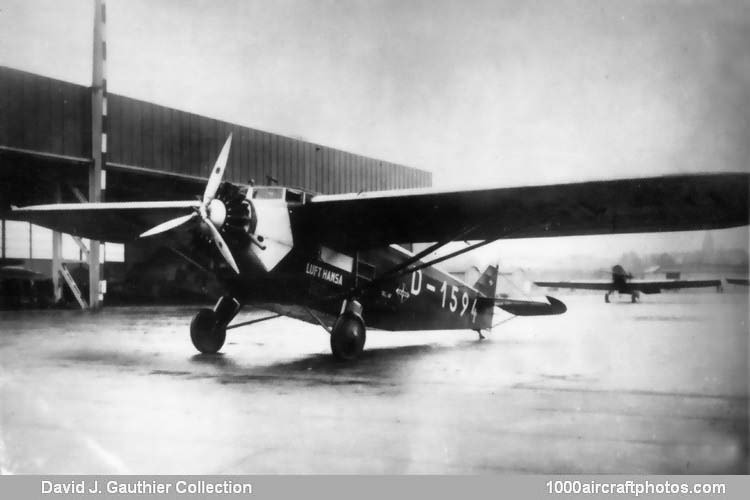Designed and constructed in 1927, the Arado V I was a prototype airliner of conventional layout, that made several long-distance flights before it was displayed at the ILA, held at Berlin, Germany, October 7-28, 1928.
The aircraft was described in the October 18, 1928 edition of "Flight-The Aircraft Engineer and Airships" (world's oldest continuously-published aviation news magazine, now known as Flight International), transcribed here as follows:
"The Arado Company, of Warnemünde, exhibits a quite new type of small passenger aeroplane, which, so far as we are aware, makes its first appearance at the Berlin Show, and has not yet been put into general service. This machine is known as the type V I (the letter V presumably standing for Verkehrsflugzeug, transport aircraft).
It is a high-wing monoplane of the semi-cantilever type, the bracing struts being intended mainly to stiffen the wing against torsional stresses. The cabin has four seats, all passengers facing forward. Aft of the cabin is a luggage compartment, while in the forward wall is a door communicating with the cockpit. The latter has two seats, side-by-side, so that if necessary two pilots can be carried, or the extra seat may be occupied by a passenger.
The fuselage is of welded steel tube construction, fabric covered over the rear portion. The fuselage decking is detachable so as to facilitate inspection of the fuselage bracing, etc. In front the engine, a 525 hp BMW-built Pratt & Whitney "Hornet" is separated from the pilot's cockpit by a fireproof bulkhead.
The petrol tanks are mounted one on each side, inside the wing, giving direct gravity feed to the carburetor. Their capacity is 585 liters (129 gallons). The monoplane wing is, as distinct from a number of German monoplanes, built in two sections to facilitate storage and transport, and is of wood construction with three-ply covering.
The landing gear is of wide track, and in an elaborate arrangement the member carrying the shock-absorbing medium (in the form of rubber rings) is not taken to the wing as in so many machines, but to the fuselage via the junction of the wing struts to a pair of short struts running to the lower longerons.
The Arado V I has an overall length of 12 m (39 ft 4 in), a wing span of 18 m (59 ft 1 in), and a wing area of 47.24 sq. m. (508.49 sq.ft). The tare weight is 1,350 kg (2,970 lb) and the permissible load 1,000 kg (2,200 lb) giving a total loaded weight of 2,350 kg (5,170 lb). The wing loading is thus 50 kg/sq.m (10.2 lb/sq.ft) and the power loading (on 500 bhp) 4.7 kg/hp (10.33 lb/hp).
No detailed performance figures are available, but the maximum speed is stated to be in the neighborhood of 200 kmh (124 mph)."
In September 1929 the aircraft was registered to Luft Hansa and used it on mail flights to Irkutsk (Russia), Seville (Spain) and Constantinople (now Istanbul, Turkey). On December 5, 1929, the aircraft made a trial mail flight between Seville and Santa Cruz, Tenerife, Canary Islands, arriving after an 860 mls (1,384 km) non-stop flight of 10 hr and 40 min. As it was the first foreign mail aircraft to arrive at Tenerife, the aircraft was baptized 'Tenerife' by the Bishop of Santa Cruz.
On December 14, 1929, the return trip was started with stops at Cap Juby (Morocco), Seville, and Marseille (France). In the early morning of December 19, the aircraft left Marseille for a non-stop flight to Berlin. Off track, the pilots attempted an emergency landing in heavy fog, near Neuruppin, some 35 mls (56 km) north-west of Berlin. The aircraft crashed, both pilots were killed, the flight engineer slightly injured."
